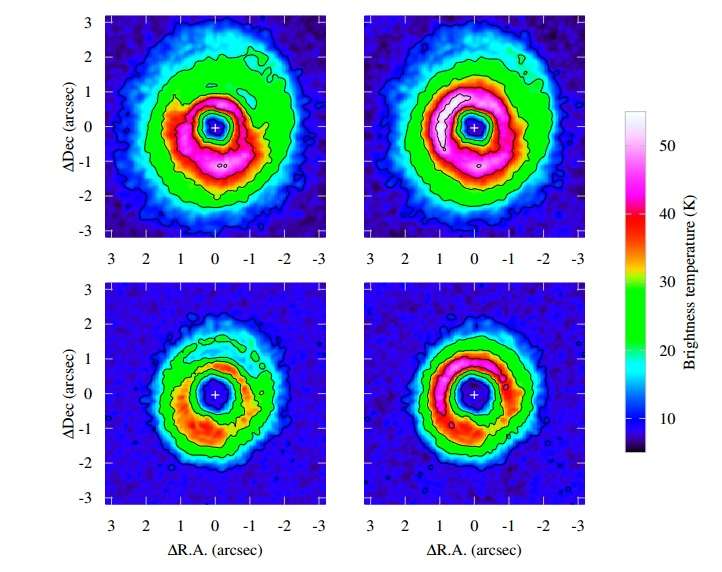April 10, 2017 report
Astronomers take a closer look at a young circumbinary disk

(Phys.org)—In a research paper published Apr. 3 on arXiv.org, astronomers presented a close-up view of the circumbinary disk HD 142527 obtained with the Atacama Large Millimeter and submillimeter Array (ALMA) in Chile. The new observations reveal the morphology and kinematics of the gas and dust emission in this disk.
HD 142527 is a young binary system with an estimated age between 2 and 5 million years. Located some 510 light years away from the Earth, this binary is best known for its protoplanetary disk. The system's primary star has a mass of about 2.4 solar masses, while the secondary star, with an orbital radius between 15 to 20 AU, is much less massive—from 0.1 to 0.3 solar masses.
The binary is at the center of a large elliptical dust cavity of approximately 120 AU in radius and of an asymmetric disk with a dense dust crescent. The dust is visible up to an orbital radius of 300 AU and traces several spiral arcs. Moreover, the primary star appears to be surrounded by a much smaller dusty disk.
Now, a team of astronomers led by Yann Boehler of the Rice University in Houston, Texas, has presented the results of new, more detailed ALMA observations of HD 142527, which uncover new insights into the nature of its disk.
"We imaged HD 142527 in the 0.88 mm dust continuum emission as well as in the 13CO and C18O J=3-2 lines at a spatial resolution of about 30-40 AU, about a factor of two better than previous observations," the paper reads.
Boehler's team conducted their observations on June 13, 2015 in dual polarization with a total time of approximately 2.9 hours and about 1.1 hour on target. The data obtained by the researchers allowed them to analyze the morphology and kinematics of the gas and dust emission in HD 142527, and compare the results with theoretical disk models.
In particular, the team found that the circumbinary disk exhibits a prominent horseshoe structure in the dust emission, while it showcases a more azimuthally symmetric morphology when observed in CO emission lines. The data also revealed that the azimuthal variations in gas and dust density reach a contrast of 54 for dust grains and 3.75 for CO molecules. Moreover, the researchers detected a compact source of dust continuum and CO emission inside the dust-depleted cavity at about 50 AU from the primary star.
"The comparison with theoretical models also indicates that the dust and CO densities vary by a factor of 54 and 3.75, respectively, between the minimum and maximum of the emission along the horseshoe structure. As a consequence, we measure a gas-to-dust ratio of 1.7 at the center of the dust crescent," the researchers wrote in the paper.
The authors concluded that this large difference between the dust and gas azimuthal distribution indicates that the horseshoe structure traps dust particles azimuthally, as well as radially. They also noted that the mean value of the gas-to-dust ratio across the circumbinary disk is much lower than expected, which could mean that HD 142527 is more evolved than normal protoplanetary disks.
More information: A Close-up View of the Young Circumbinary Disk HD 142527, arXiv:1704.00787 [astro-ph.EP] arxiv.org/abs/1704.00787
Abstract
We present ALMA observations of the 0.88 millimeter dust continuum, 13CO, and C18O J=3-2 line emission of the circumbinary disk HD142527 at a spatial resolution of about 0.25". This system is characterized by a large central cavity of roughly 120 AU in radius, and asymmetric dust and gas emission. By comparing the observations with theoretical models, we find that the azimuthal variations in gas and dust density reach a contrast of 54 for dust grains and 3.75 for CO molecules, with an extreme gas-to-dust ratio of 1.7 on the dust crescent. We point out that caution is required in interpreting continuum subtracted maps of the line emission as this process might result in removing a large fraction of the line emission. Radially, we find that both the gas and dust surface densities can be described by Gaussians, centered at the same disk radius, and with gas profiles wider than for the dust. These results strongly support a scenario in which millimeter dust grains are radially and azimuthally trapped toward the center of a gas pressure bump. Finally, our observations reveal a compact source of continuum and CO emission inside the dust depleted cavity at about 50 AU from the primary star. The kinematics of the CO emission from this region is different from that expected from material in Keplerian rotation around the binary system, and might instead trace a compact disk around a third companion. Higher angular resolution observations are required to investigate the nature of this source.
© 2017 Phys.org





















